I'm sure this has come up before, but I can't locate it....Does anyone know if the aforementioned hybrids retain the pharyngeal plate??
Awesome question, and a post that I've been meaning to create for some time. Tony I don't think enough research has been performed to address the questions regarding inherited traits of BRES - RBG hybrids - but maybe we can work together to advance the research efforts.
Let me add a few for our experts they can hopefully address:
Does gender of parentage species play a factor on genes inherited?
After several generations of interbreeding, will subsequent generations adopt more BG or RES traits? [HBG following several generations of interbreeding assume GSF traits - what about BRES-RBG?]
Start with this from a 1972 study. Things have changed a lot since then but you can see the basics here. Back later with more.
LINKAGE RELATIONSHIPS OF SIX ENZYME LOCI IN INTERSPECIFIC
SUNFISH HYBRIDS (GENUS LEPOMIS)*
T. E. WHEAT2 AND G. S. WHITT3
Department of Zoology, University of Illinois, Urbana, Illinois 61801
and
W. F. CHILDERS
Section of Aquatic Biology, Illinois Natural History Survey, Urbana, Illinois 61801
Manuscript received December 19, 1972
Backcross hybrids produced from the bluegill, the red-ear sunfish, and their
F, interspecific hybrid have been analyzed for the inheritance of six enzyme
phenotypes.
From the analysis of the F, hybrids, we can conclude that all six loci are present
and functional with both alleles at each locus being expressed to the same extent.
Linkage analysis in backcross hybrids: Table 1 presents the frequencies of
TABLE 1
Allele frequrncy: RB F, 8 X R 0
!tlnll-A >lD€l-R Est ro &PDII BPGDH
Homozygotes 76 62 67 68 62 65
Heterozygotes 64 78 73 72 78 75
ISOZYMES IN SUNFISH HYBRIDS
TABLE 2
Allele frequency: RB F, 8 x B 0
347
MDH-A MDH-B Est TO rrGPDH GPGDH
Homozygotes 53 58 69 58 68 70
Heterozygotes 67 62 51 62 52 50
homozygotes and heterozygotes for all six markers among the progeny of
8 F, X 9 red-ear sunfish. Similar data for the mating 8 F, x P bluegill are
given in Table 2. There is no significant deviation from the expected ratio of
1 homozygote to 1 heterozygote for each locus at the 99% significance level.
However, it is possible that there is an increased frequency of the bluegill allele
for aGPDH in both crosses reflected in excess homozygotes in the backcross to
the bluegill, and excess heterozygotes in the mating with the red-ear sunfish.
The excess of individuals receiving the bluegill allele from the Fl parent
(146/114) is significant at less conservative confidence limits (x2 = 3.94;
.01 < p < .05). These observations are consistent with the inheritance of the
parentally derived genes as codominant alleles at nuclear loci. In addition, there
are no apparent differences in viability between the two reciprocal backcrosses,
confirming the suitability of this genetic system for linkage analysis.
Tables 3 and 4 show the distributions of parental phenotypes and presumed
recombinant classes for the fifteen pairs of markers in the matings of the F,
hybrid with the red-ear sunfish and the bluegill, respectively. The x2 value is
calculated for the deviation of the observed data from the 1:1:1:1 distribution
TABLE 3
Linkage relationships: RB F, 8 X R 0
99p
homA het A hom A het A Percent confi ence
A B homB het B het B homB x2 recombination limit
MDH-A MDH-B 33 35 43 29 .MO 51.4 10.9
MDH-A Est 32 29 44 35 2.20 56.4 10.8
MDH-A TO 39 35 37 29 .5ai 47.1 10.9
MDH-A 6PGDH 37 37 39 27 .616 47.1 10.9
MDH-A aGPDH 35 37 41 27 ,210 48.6 10.9
MDH-B Est 32 43 30 35 .629 46.4 10.9
MDH-B TO 31 41 31 37 .091 48.6 10.9
MDH-B 6PGDH 29 42 33 36 .005 49.3 10.9
MDH-B aGPDH 25 41 37 37 ,708 52.9 10.9
Est TO 29 34 38 39 1.44 55.0 10.8
Est 6PGDH 24 32 43 41 5.81 60.0 10.7
Est aGPDH 22 33 45 4.0 6.83 60.7 10.6
TO 6PGDH 32 39 36 33 .021 49.3 10.9
TO aGPDH 29 39 39 33 ,144 51.4 10.9
6PGDH* aGPDH 53 66 12 9 68.2 15.0 7.79
* These two loci show significant linkage.
348 T. E. WHEAT AND G. S. WHITT
TABLE 4
Linkuge relationships: RB F, 8 X B Q
A
99%
homA hetA homA hetA Percent confidence
B homB het B hetB homB x2 recombination limit
MDH-A
MDH-A
MDH-A
MDH-A
MDH-A
MDH-B
MDH-B
MDH-B
MDH-B
Est
Est
Est
6PGDH
TO
6PGDH*
MDH-B
Est
6PGDH
TO
aGPDH
Est
6PGDH
TO
(uGPDH
GPGDH
TO
aGPDH
TO
aGPDH
aGPDH
29 38 24 29 1.55
33 31 20 36 382
34 31 19 36 1.08
25 34 28 33 .051
29 28 24 39 .I47
36 29 22 33 ,959
33 25 25 37 .a95
24 28 34 34 2.17
28 22 30 40 3.22
45 26 24 25 3.16
30 23 39 28 1.53
45 28 24 23 4.84
27 19 43 31 6.41
31 25 27 37 ,474
56 38 I4 12 37.2
4.4.2 11.7
46.7 11.7
45.8 11.7
50.8 11.8
52.5 11.8
45.8 11.7
51.7 11.8
56.7 11.7
58.3 11.6
40.8 11.6
55.8 11.7
39.2 11.5
61.7 11.5
53.3 11.7
21.7 9.7
* These two loci show significant linkage.
expected for unlinked loci. The frequency of recombination (MATHER19 51)
and the confidence limit at the 99 % level are also presented.
In both tables (3 and 4), there are no significant deviations (99% limit) from
random assortment for the first fourteen pairs of markers; the frequencies of
recombination are on the order of 50%. These data are not significantly different
from the random assortment of codominant alleles at unlinked nuclear loci.
However, loose linkage cannot be excluded.
In contrast, for both backcrosses, GPGDH and (uGPDH show highly significant
deviations from random assortment, and the calculation of the frequency of
recombination confirms linkage between these two markers. The recombination
values calculated for both backcrosses are not significantly different, so the true
frequency of recombination is probably between 15% and 22%.
Other possible deviations are found for Est-aGPDH in the backcross to the
red-ear sunfish (x2 = 6.83; 0.01 < p < 0.05), and for GPGDH-TO in the backcross
to the bluegill (x2 = 6.41; 0.01 < p < 0.05). In view of the large number
of tests, it is probably better to consider only differences at the more conservative
limit. In any case, these deviations could not reflect linkage since the observed
frequency of recombination exceeds 0.5.
DISCUSSION
These data clearly demonstrate the utility of interspecific sunfish hybrids for
genetic analysis. The viability of the interspecific hybrids and their progeny, as
well as the large number of isozyme markers, is particularly advantageous. All
six markers examined are inherited in a mendelian manner as codominant alleles
at nuclear loci. There is no allelic repression detected in these interspecific
ISOZYMES IN SUNFISH HYBRIDS 349
hybrids, although allelic inhibition has been observed for interspecific sunfish
hybrids formed from more distantly related species (WHITTC, HOa nd CHILDERS
1972). No differential mortality was detected in either backcross population.
Finally, no significant differences between the reciprocal crosses were detected.
The slight excess of bluegill alleles for (rGPDH in both crosses probably reflects
statistical variation due to the large number of tests being made. However, it may
reflect differential mortality or some other distortion of the patterns of inheritance.
Additional data would be necessary to clarify this point.
The absence of close linkage between the MDH-A and MDH-B loci has been
previously observed in the backcross between the RB F, hybrid and the red-ear
sunfish (WHEATW, HITTa nd CHILDER1S9 72). This conclusion is confirmed by
the present study. Since the two supernatant MDH loci (A and B) of teleosts are
such closely homologous duplicate genes (BAILEY et al. 1970), the absence of close
linkage may be of developmental or evolutionary significance. These data are
consistent either with tandem duplication followed by some form of chromosomal
rearrangement or with duplication during an ancient polyploidization event
(OHNO 1970).
The significance of the linkage of the loci encoding 6-phosphogluconate dehydrogenase
and the liver form of a-glycerophosphate dehydrogenase for metabolic
regulation is doubtful since the enzymes are in different metabolic pathways.
These loci are unlinked in Drosophila (Fox, ABACHERLaIn d URSPRUNG19 71).
Since recombination occurs with a frequency of 15 %-20% between these linked
loci, recombination between the parental chromosomes in the F, hybrid is clearly
demonstrated in this case. No data are available concerning the frequency of
recombination between these loci in the parental species, so it cannot be determined
whether the frequency of recombination is altered in the F, hybrid. Apart
from its intrinsic genetic interest, the observation of linkage is of special significance
to other studies of interspecific sunfish hybrids. The presence of linked
enzyme loci should be very helpful in investigating the mechanisms of synchrony
of gene function during development. In addition, the determination of the
specificity of the mechanisms responsible for allelic repression in interspecific
hybrids could be assessed with linked enzyme loci, The observations that recombination
can occur between these linked loci in the F, hybrid, and that there is no
substantial difference between the two backcross populations, clearly demonstrate
the utility of this interspecific sunfish hybrid system for further genetic
analyses.
Does anyone know if the aforementioned hybrids retain the pharyngeal plate??
Sparkie, I think if you examine the relationship between
Linkage RB F, 8 X R 0
99p
homA het A hom A het A Percent confidence
A B homB het B het B homB x2 recombination limit,
and
TO aGPDH 29 39 39 33 ,144 51.4 10.9
6PGDH* aGPDH 53 66 12 9 68.2 15.0 7.79
with the assumption that at the 99% conidence limit,
29 38 24 29 1.55
33 31 20 36 382
34 31 19 36 1.08
25 34 28 33 .051
29 28 24 39 .I47
36 29 22 33 ,959 is not playing a limiting role,
the answer is rather obvious:
"Maybe".
In the interest of applied, rather than pure, science, I would suggest the next set of videos posted by Gar King be of himself inserting his index finger into the pharyngeal space of several 1 pound RES vs BG hybrids. Examination of the condition of the retrieved digit should provide a definitive answer to this question, as well as bring forgiveness from Sunil for any future maceration of the english language.
Eric, could you make a answer a little more complex. I hate such simple dribble. YS, thank you for my lottery numbers for the rest of the year. Maybe "Ruby Don't Take Your Loving To Town" would not have been so successful if Viagra had been available back then,"Maybe".
I nominate Yolk's post above for POTY.
It all seems so simple when Yolk explains it. And to think I was about to demonstrate my ignorance for the entire world to see by asking ewest if his post was available in CliffsNotes....for those like me who don't make a living by speaking fish. Now THAT would've been embarrassing to admit.
Thanks for clearing that up and letting me save face Yolk!
I nominate Yolk's post above for POTY.
...and I will probably embarrass myself by asking..... POTY???? That's not in the acronym list.
I nominate Yolk's post above for POTY.
...and I will probably embarrass myself by asking..... POTY???? That's not in the acronym list.
Made up on the fly. Post Of The Year.
If you want the study PM me an email address.

Did not have time to clean up the charts so they made sense.
Point is this is very complex stuff with a lot of unknowns even at this point. I will put up some different info that is clearer.
How about this: Can anyone post some photos of the pharyngeal plate/teeth of a RES? We have a number of these fish that occur naturally in our ponds, (I caught 4 nice specimens this weekend), and I will open some up and take a look.....provided I know what to look for.
Ewest, thank you for your efforts. Much appreciated!

TEMPO OF HYBRID INVIABILITY IN CENTRARCHID FISHES
(TELEOSTEI: CENTRARCHIDAE)
DANIEL I. BOLNICK1,2 AND THOMAS J. NEAR3,4
Asymmetries in F1 Hybrid Viability
Centrarchid hybrid viability differs between reciprocal
crosses of the same pair of species (F1 asymmetry). Of 18
species pairs for which reciprocal crosses have been done
(and viability is nonzero), 17 had significantly different viabilities
depending on which species was the female (or male)
parent. The relative strength of this asymmetry increased linearly
with time (Fig. 4), because the absolute difference in
viabilities was fairly constant and represented an increasing
proportion of the overall viability as the latter measure declined.
Asymmetrical F1 viabilities may also result from deleterious
interactions between the maternally provided oocyte
cytoplasm and the hybrid’s nuclear genes. Centrarchid hybrids
show aberrant timing of allozyme gene expression during
early development, even when the parental species have
identical onset of gene expression (Phillip et al. 1983). These
results suggest that centrarchid species have diverged in their
gene regulation mechanisms even while expression location
and timing remained similar. In many cases, hybrids expressed
maternal alleles at the normal time, but paternally
derived alleles were delayed, premature, or failed to be expressed
at all (Phillip et al. 1983). Less viable hybrids in a
reciprocal cross are generally the ones with greater paternal
allele misexpression. Whitt et al. (1977) suggested that the
greater effect on paternal alleles is evidence for cytoplasmicnuclear
interactions, hypothesizing that maternally encoded
regulatory signals are misinterpreted by the paternal allele.
If one species’ gene expression is more sensitive to changes
in transcription factors, asymmetries will result.
One puzzling pattern
to emerge from our data lends some credence to a role for
cytonuclear interactions: using maximum body size as an
index (Page and Burr 1991), the larger species tends to be
the more successful maternal parent (Table 3). Of the 18
species pairs with reciprocal cross data and nonzero viability,
one pair had equal body size and nearly symmetrical crossing
success. Focusing on the remaining 17 species pairs (admittedly
not phylogenetically independent; Table 3), the larger
parent was more successful in 13 crosses and less successful
in four crosses (x12 5 4.765, P 5 0.029). We speculate that
there is greater disruption of paternal allele expression when
the paternal allele is from a smaller species, placed in an egg
with cytoplasmic factors encoded by a larger maternal species.
However, the cytoplasmic effect cannot be attributed to
differences in egg size, as egg size is not correlated with
body size (D. I. Bolnick, unpubl. data) and egg size differences
are not associated with inviability (Merriner 1971b).
We are working on expanding our dataset to include more
reciprocal crosses to test this pattern more rigorously
HAVING POSTED THIS ON CENTRAS NOTE THAT RES X BG SEEM TO BE THE EXCEPTION FOR SEVERAL REASONS INCLUDING NEAR SIMILAR SIZE OF THE TWO SPECIES AND DO CROSS WELL IN BOTH DIRECTIONS.
How about this: Can anyone post some photos of the pharyngeal plate/teeth of a RES? We have a number of these fish that occur naturally in our ponds, (I caught 4 nice specimens this weekend), and I will open some up and take a look.....provided I know what to look for.
See this for info and pics
http://intarch.ac.uk/journal/issue3/colburn/1intro.html
Tony please post pics of your BRES...or email them to me. Want to review and admire.
Well, now we understand why you have to hire a Lawyer to interpret the law.
I wanted to revive this thread to see if any further info has been gathered, and get some ideas on what to look for or avoid if Bruce and I tackle a small (600 Sq Ft) breeding pond for male RES and female NBG.
Any input is appreciated.
No additional information but sounds like an interesting project.
What are your goals and intentions for the offspring. I assume such a small pond the idea is to create hybrid offspring to stock somewhere else?
Right now my plan is to create hybrid offspring and share them with TJ, Shorty, Bruce and any other local pond bossers to see how they respond. Just kids playing with toys essentially

Don't you come up this way in early September for Husker Harvest days? We may have to make arrangements to send a few home with you!!
How many are you trying to produce? A small pond may be more than you need for the actual spawning part.
I have no limit on how many we want to produce. I'll throw a few in my .65 acre RES/SMB pond, give a few to Shorty, TJ and Bruce and then throw the rest in my 15 acre pond. I've just recently built a 600 sq ft pond and was going to put it to use growing out BG. Bruce suggested we grow out hybrids instead.
I sense you've got suggestion on how to do such in a tank as I've read a lot of your prior posts. I'd love to get some more detail on how to do such. I was hoping you'd chime in on this. Thanks for taking the time.
You could get spawns off in a stock tank and transfer the prolarvae-laden nest(s) to ponds prepped for rearing. That would allow more control over numbers and 1 cohort so you can have 4" plus fish by the following fall that would require a lot less grading.
Tricks of the trade to get a spawn off in a stock tank?
High school kids can do it so I would not say they are tricks. You could also do it in a larger aquarium. I can breed 2-lb sunfish in 75-gallon tanks without too much trouble.
Right now my plan is to create hybrid offspring and share them with TJ, Shorty, Bruce and any other local pond bossers to see how they respond. Just kids playing with toys essentially

Don't you come up this way in early September for Husker Harvest days? We may have to make arrangements to send a few home with you!!
That would be neat. Yes I am planning on HHD. It is September 11-13th. Planning on looking you up too.
Here is what I believe to be a RESxCNBG hybrid. Right at 10" length.
It is definitely a hybrid because the ear tab is not solid black like on a pure BG.
It lacks any green bars on the cheeks and it has a small mouth so I see no GSF involved.
It does have the mottled cheeks like a RES and has an off color red border on the ear tab that could indicate RES. Hybrids with GSF genes can also introduce an orange-ish translucent tab border, but since the fish lacks other GSF characteristics I say the border is from RES genes.
The only sunfish in the ponds are BG, CNBG, RES and a few GSF so those are the possibilities.
The biggest chance for hybridization would have been RESxCNBG (what was stocked in my sediment pond where I got so many hybrids produced) so it is likely that is what this fish is. But it could also possibly be from northern BG (from my main pond). I wish I would have taken a few more pictures from different angles. The RES mottled yellowish cheeks shown up much better in person than in the picture.
Description: What I believe to be a RESxCNGB hybrid

Looks like a standard HBG to me from the pic. Could easily be another cross however. Could also be a 3 way cross.
Guessing GSF genetics in there due to yellow pelvic, anal, caudal fins - but like Eric says could easily be a F2, F3, F4 fish with multiple parental species genetics present. I'm not too familiar with CNBG but have seen some with a yellowish color on fins, but not that pronounced in my super limited experience. Regardless it's a beautiful fish.
OK went back and looked closer and here is pic. When blown up you can see it has some white fin edges which is a CNBG trait. Appears to have CNBG nose scale patterning. Lateral line looks CNBG. Pect fin looks BG not RES. Also the white and yellow by the ear flap does not seem to be an edge margin but rather coloration under the flap (actual exam would disclose this better ). I think this is mostly BG but could have some GSF or RES genes. My guess is a very high % CNBG.
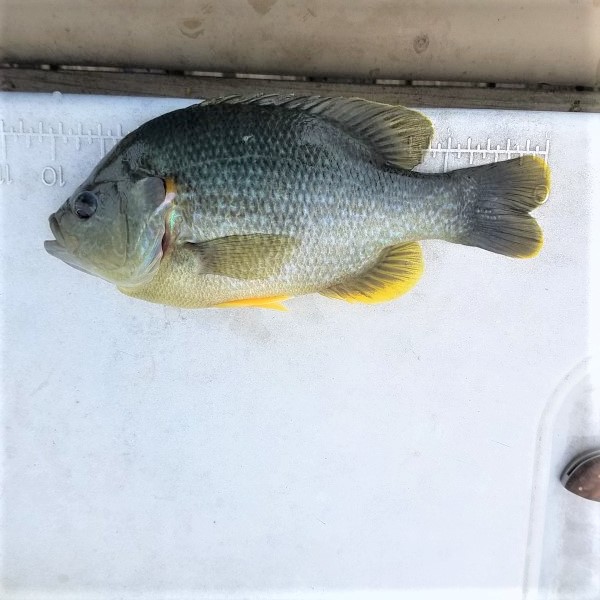
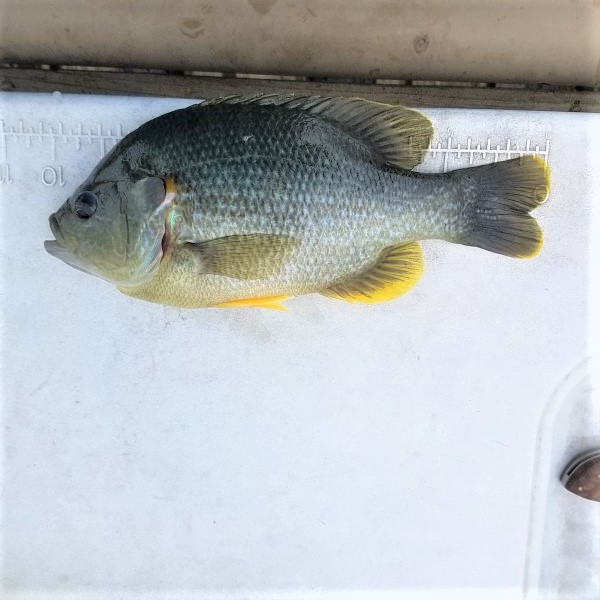
You both may be right but all my hybrids that have GSF have significantly larger mouths. That was the main reason I guessed it was one with RES genetics.
But if It was other than an F1 it could be showing different characteristics than what I am used to seeing.
The mottled yellow on the cheeks looks just like the cheeks of my RES
Doesn't look like any of my other CNBG male or female but could also be natural variation in the species if it was pure CNBG.
Like I said, wish I had taken more pictures.
Northern BG x RES from a local lake, caught three of them this afternoon.


That is one handsome fish, shorty.
Here is what I believe to be a RESxCNBG hybrid. Right at 10" length.
It is definitely a hybrid because the ear tab is not solid black like on a pure BG.
It lacks any green bars on the cheeks and it has a small mouth so I see no GSF involved.
John, I agree with your comments about lacking some of the HBG traits but one trait still seems to be present, the yellow margins on the caudal and ventral fins seem to display at least some GSF (or do CNBG also have yellow fin margins?). I thought RES traits are displayed in this fish also. dlowrance is going to post some photos of RESxGSF and wonder if any will look similar this specimen.
Northern BG x RES from a local lake, caught three of them this afternoon.

Are you certain that Pumpkinseed are not in that pond?
Northern BG x RES from a local lake, caught three of them this afternoon.

Are you certain that Pumpkinseed are not in that pond?
Yes quite certain, this lake was stocked with both BG and RES when it was built a few years ago. Pumpkinseeds are extremely uncommon in Nebraska with small populations found primarily in the north central part of the state in the sandhills. All three of the hybrids I caught had elongated pectoral fins typical of RES. Here is a write up on the lake.
http://magazine.outdoornebraska.gov/2015/03/new-reservoir/https://www.nefga.org/forum/fishing-and-hunting/nebraska-fishing-forum/1125212-fish-id-helphttps://www.nefga.org/forum/fishing-and-...-action-tonight
.jpg)
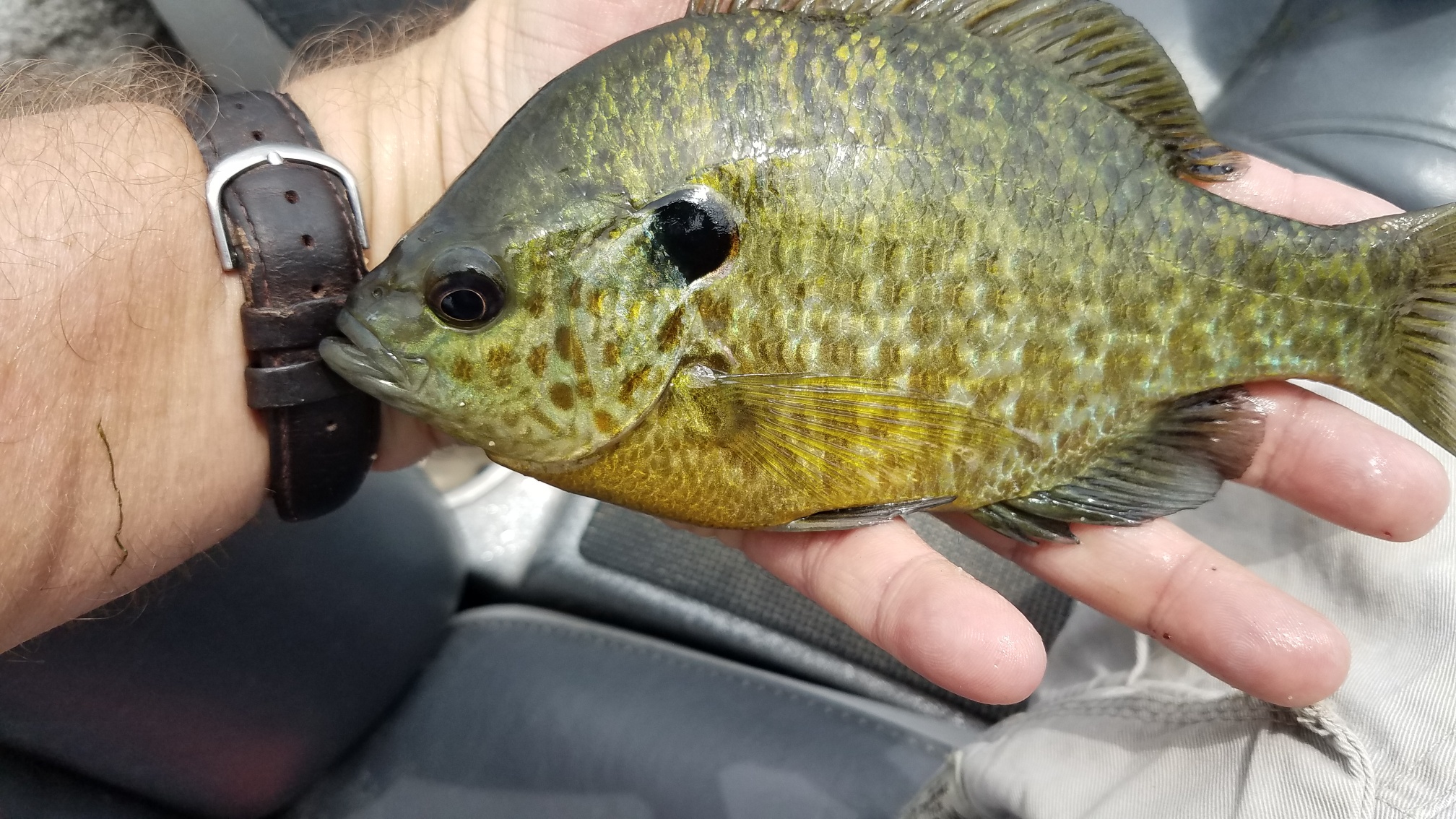
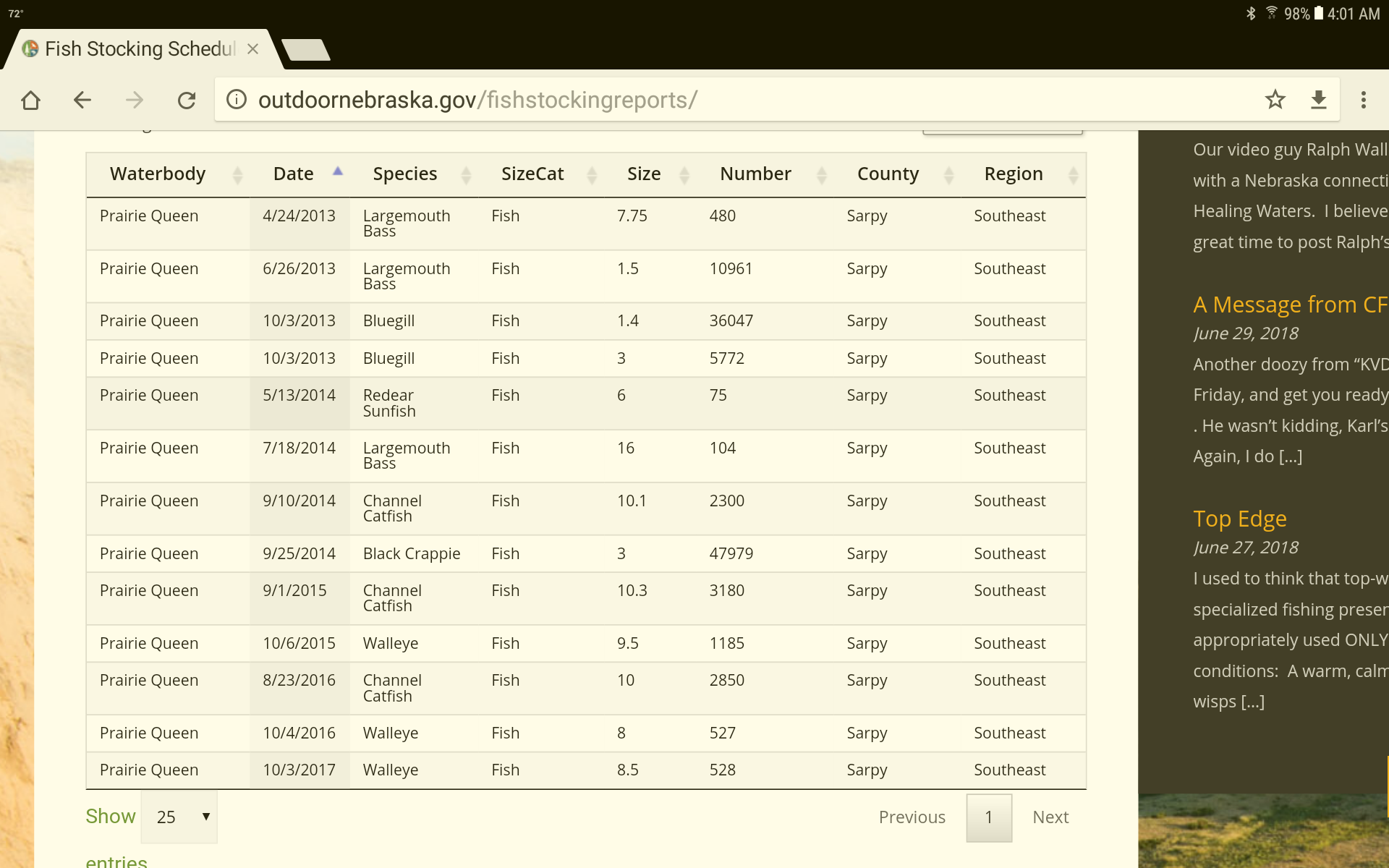
Here is what I believe to be a RESxCNBG hybrid. Right at 10" length.
It is definitely a hybrid because the ear tab is not solid black like on a pure BG.
It lacks any green bars on the cheeks and it has a small mouth so I see no GSF involved.
John, I agree with your comments about lacking some of the HBG traits but one trait still seems to be present, the yellow margins on the caudal and ventral fins seem to display at least some GSF (or do CNBG also have yellow fin margins?). I thought RES traits are displayed in this fish also. dlowrance is going to post some photos of RESxGSF and wonder if any will look similar this specimen.
The things about the fish that say RES to me are the things that are not very reliable indicators. Not very clear in the picture but the mottled yellow on the cheeks look very much like the mottled yellow on my RES and Shorty's hybrid pictures. That and the eyes when I held it in my hand are what said RES to me but I also recognize that those are not very definitive or reliable fratures.
The pectoral fin is short, unlike RES.
I suppose it is also possible a RESxGSF hybrid crossed with a BG, giving a cross with only 1/4 GSF. That could explain multiple characteristics yet the mouth size more associated with RES or BG rather than the more typical large mouth we are used to seeing in anything crossed with GSF. The larger mouth seems to be a very dominant transferable trait of the GSF.
It is definitely a mutt.
One positive thing about mutts, they will bite a hook. Yesterday was really hot. Too hot to be fishing but I did anyway. The large BG were hardly biting. But the mutts and small BG were still willing to bite pretty well. It is a good time to do some culling and I did.
I have made crosses involving Northern Bluegill with both Redear and Pumpkinseed; a lot of them over the years. Color pattern on flanks show spotting and opercula show radiating lines, both characters of Pumpkinseed which the Redear lacks. If Pumpkinseed are rare, then that sets the stage for hybrids involving it. Somebody does not have a good handle on what species are present in the lake.
[quote=jpsdad][quote=snrub]
One positive thing about mutts, they will bite a hook. Yesterday was really hot. Too hot to be fishing but I did anyway. The large BG were hardly biting. But the mutts and small BG were still willing to bite pretty well. It is a good time to do some culling and I did.
In all my confusion of what may have created such a fish ... I forgot to comment on just how good it looks. Hefty and long and in good proportion. Just me maybe, but I wouldn't mind culling a BUNCH of fish like that.
I have made crosses involving Northern Bluegill with both Redear and Pumpkinseed; a lot of them over the years. Color pattern on flanks show spotting and opercula show radiating lines, both characters of Pumpkinseed which the Redear lacks. If Pumpkinseed are rare, then that sets the stage for hybrids involving it. Somebody does not have a good handle on what species are present in the lake.
Is this the type of "spotting" you are referring too? We are at the tail end of the primary spawnining season here. I'm confused, do you have pictures? Pumpkinseeds are rare in SE Nebraska. GSF on the other hand are in most watersheds, it would not be uncommon to find a few in new or renovated lakes around here but these do not look like GSF hybrids due to the elongated pectoral fins.
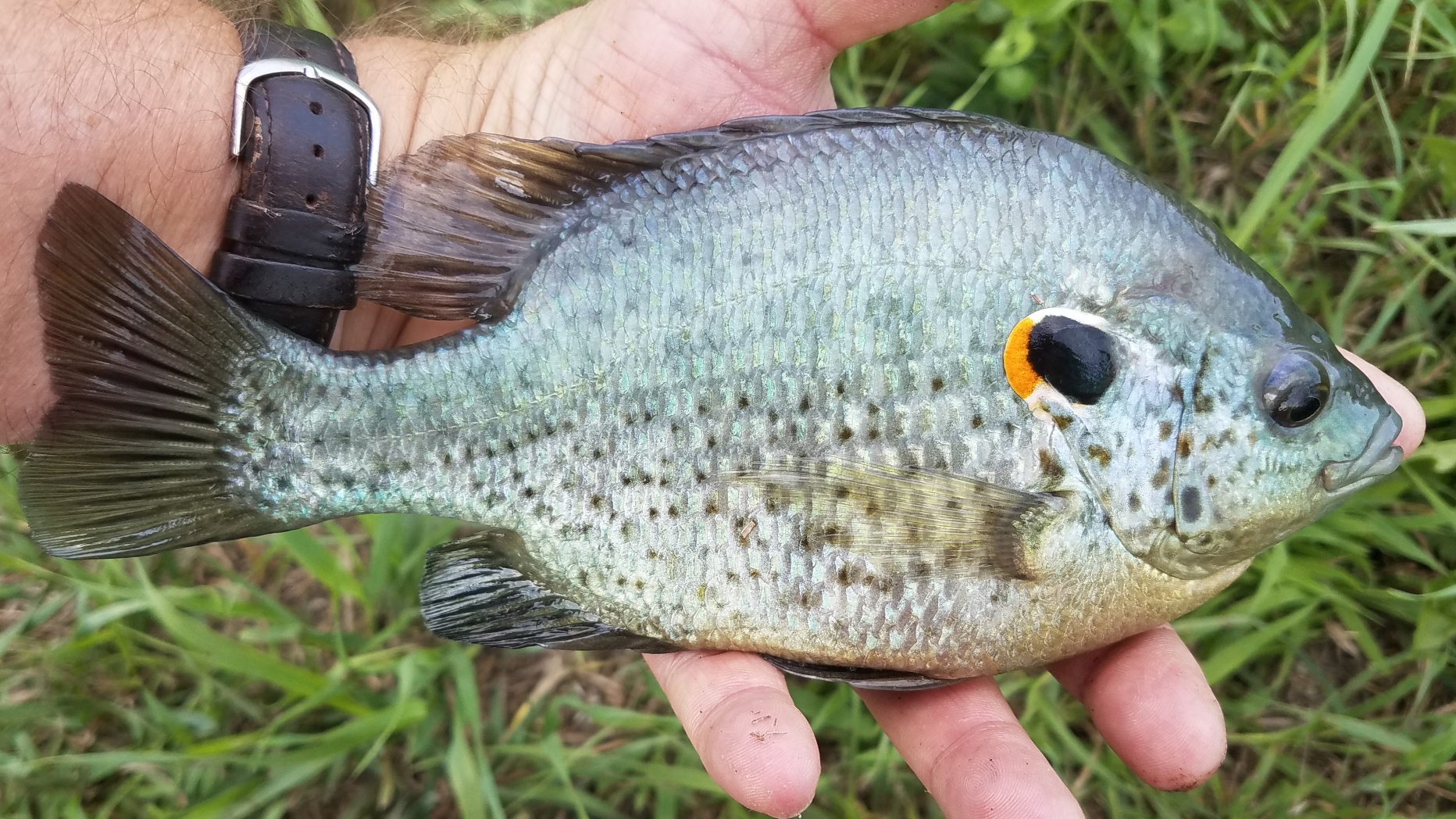
Pumpkinseed with spotting pattern that is dominant. Also note lines on operculum.
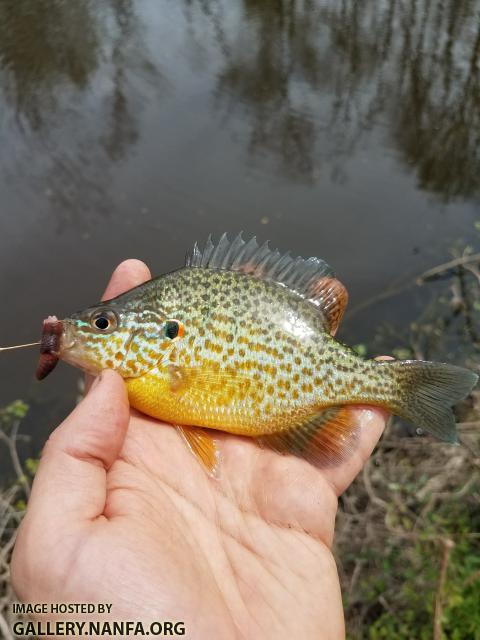
Very likely that there is more pumpkinseed genetics in that fish than RES.
Dave Willis researched pumpkinseed presence in the Nebraska SandHills lakes area. If you are interested see this article:
https://digitalcommons.unl.edu/cgi/viewcontent.cgi?article=1024&context=tnasIt would be useful to continue to fish those lakes near you to see if more pumpkinseed traits show up (more yellow on the belly, red on the ear tab, as per the picture just above this post)
Omaha is a 3 to 4 hour drive from the where Dr. Willis's did his study and that is about as far south as their natural range is in the state. We do have orange spotted sunfish present in low numbers in the area but no pumpkinseed. The only way to know for sure would be to physically examine the gill rakers. Long time ago I took in what looked like a pumpkinseed in for a state record application, a physical examination of the gill rakers at UNL determined that is was a GSF x BG hybrid, a non standard cross from what most hatcheries do.
Wowzers, I'm impressed that they can figure out a GSHxBG cross just by looking at the gillrakers!? That is some serious specialty skill to say the least!
I'm curious why do the pumpkinseed not like it in Omaha (or in Fort Wayne, IN, or other similar locations at that latitude?) IS it really the heat in summer compared to say northern NE or to the lakes an hour north of GR where we find pumpkinseed?
Wowzers, I'm impressed that they can figure out a GSHxBG cross just by looking at the gillrakers!? That is some serious specialty skill to say the least!
I'm curious why do the pumpkinseed not like it in Omaha (or in Fort Wayne, IN, or other similar locations at that latitude?) IS it really the heat in summer compared to say northern NE or to the lakes an hour north of GR where we find pumpkinseed?
Fisheries Biologist look at stuff like gillrakers, they vary quite a bit between sunfish in both length and numbers. I did check one of the lakes the SD paper was based on, that lake is 357 miles away and near the SD border and a 6 hour drive from Omaha.
Not sure why we don't have pumpkinseeds this far south, best guess is temperatures are too warm and not enough aquatic vegetation in most lakes in this part of the state, surface temps are already in the mid 80's now.
http://www.seagrant.wisc.edu/home/Default.aspx?tabid=605&FishID=21Gill Rakers
Bluegill 13-16, moderately long
Pumpkinseed 9-12, short and thick
Sunfish, Green 11-14, long and thin
Sunfish, Longear 9-11, short and thick
Sunfish, Orangespotted 10-15, long and thin
Warmouth 9-12, moderately long
BGXGSF Hybrid, notice the intermediate appearance of the gill rakers

BGXPumkinseed Hybrid, notice the intermediate appearance of the gill rakers.

GSF X BG Hybrid

Pumpkinseed X BG Hybrid

I will add this link as well.
http://www.bigbluegill.com/m/blogpost?id=2036984%3ABlogPost%3A4024
Looks like the hybrid kept the shorter pectoral fins of the BG.
Are Orange-spotted Sunfish in the system from which hybrid of interest was sourced?
I am not keen on using morphological characters for determining direction of sunfish crosses. Mitochondrial DNA better suited for that.
Are Orange-spotted Sunfish in the system from which hybrid of interest was sourced?
OSS would be a remote possibility but the lake was built up in the hills, there is not much above where it was built. OSS are more likely to be found in the feeder creeks in river valleys. Sexually mature RES were stocked and LMB were the first fish stocked to clean out undesirables.

Many surveys may ignore OSS like they do with mosquito fish and other species that not of fisheries value. The OSS does readily cross with NBG and the hybrid can have characters not unlike I suggested for the PS hybrid involving NBG.
Just my two cents ...
The link to the images of Dr. Bruce's
BGxRES has a corresponding thread right
here in the Pond Boss Forum. Dr. Bruce documents how he cultured the hybrid and we can be certain there is no PS or OSS in his hybrid.
They look pretty much the same. Shorty catches both BG and RES in this lake but has yet to catch a PS or OSS. Isn't the simplest most reasonable identification the one Shorty originally posted?
My thoughts as well, keep in mind there are very few pictures of BGxRES hybrids to compare with. The ones I caught at Prairie Queen all appeared to be male unlike the one Bruce posted a picture of. I would also point out that RES also have a faint spotting pattern on the flank, it's just blueish or blackish rather than orange. While I can't be certain of the parentage of these hybrids the long pectoral fins scream RES, it was one of the first things I noticed.
Shorty,
You are aware that there is a fish farm that produces and sells BGxRES hybrids on a large scale and sells them? I'm sure they can give you many pictures of all different ages and sizes if that helps us recognize them?
There is a thread or two about these and they have been given their own 'name' of southern specklebelly sunfish (SSS) to help market them.
Would they be able to help based on their experience with this particular hybrid?
Hatcheries typically produce one type of cross such as male BG x female GSF. A male GSF x female BG will produce a very different looking offspring so naturally occurring hybrids may look very different than the hatchery standard. I have seen pictures the southern specklebelly, I would like to see what they look like at larger more mature sizes.
Just my two cents ...
The link to the images of Dr. Bruce's
BGxRES has a corresponding thread right
here in the Pond Boss Forum. Dr. Bruce documents how he cultured the hybrid and we can be certain there is no PS or OSS in his hybrid.
They look pretty much the same. Shorty catches both BG and RES in this lake but has yet to catch a PS or OSS. Isn't the simplest most reasonable identification the one Shorty originally posted?
Thanks for looking up that link to the old thread and posting it here. I had not run across that one before. Really interesting.
It is really beneficial, in my opinion, when old threads with related information are linked in new threads.
You are welcome John. I'm sorry it took me so long to find it. I kept searching under "ever evasive" instead of "coveted" which held up my finding it.
Mr Condello hasn't posted on here since October 2015. Is he still doing pond stuff? What happened?
He appeared with Bob Lusk on one of the facebook videos, if I recall correctly. Other than that, the last I heard was that he was focusing on his site, bigbluegill.
Hybrid? I think I should post this question here, rather than the sexing RES thread. My apologies.
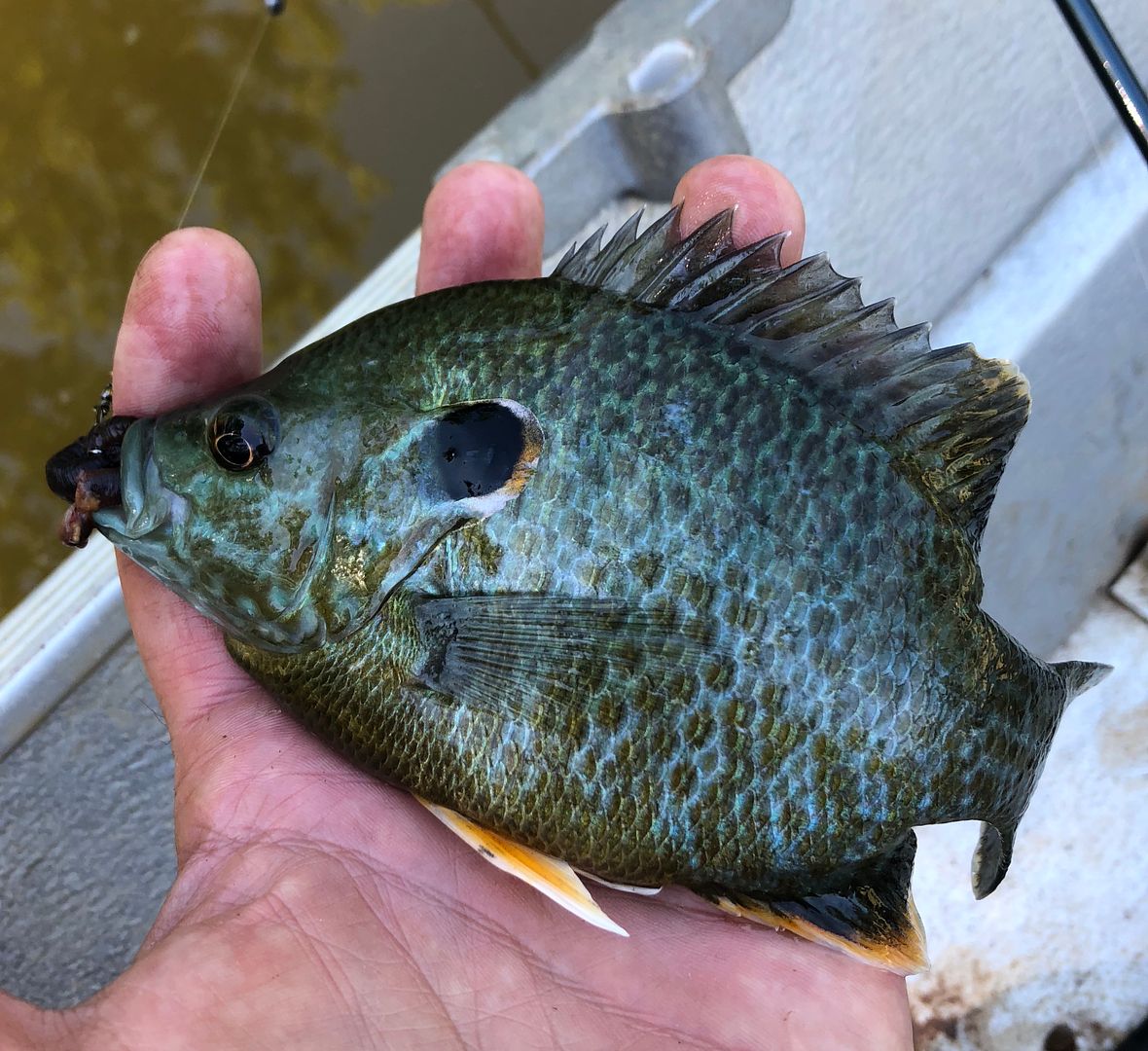
Bruce is doing great. He’s working on a RES x BG project at his pond right now. Not sure why he doesn’t post but he’s as fish crazy now as he’s ever been.
Hybrid? I think I should post this question here, rather than the sexing RES thread. My apologies.

Yes! Not sure what kind but if I had to guess it would be a female RES x male HBG. Regardless, that is one cool looking fish.
Hybrid? I think I should post this question here, rather than the sexing RES thread. My apologies.
Yes! Not sure what kind but if I had to guess it would be a female RES x male HBG. Regardless, that is one cool looking fish.
That’s why I took a picture of it. I thought it looked cool also.
Thx
Nice work using Wisc Fish site. Great info and pics.







.jpg)










